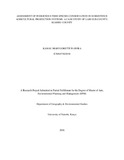| dc.description.abstract | Conservation of indigenous trees is important because they regulate nutrients, build organic matter of top soil, fix nitrogen and create habitat for beneficial soil micro-organisms. The objective of this study was to assess existing on farm indigenous tree species in Lari Sub-County, their location on the landscape and rationale for retaining them. Lari Sub County was purposively selected because of the land use/ cover changes since the 1940’s. Kinale ward was selected because it has a higher percentage of indigenous forest cover while Kijabe has most of its forests converted to agricultural and other land uses due to population pressure. Systematic sampling was used to identify 57 farms in Kinale ward and 39 farms in Kijabe ward.
Data was collected using structured questionnaires, complemented by key informant interviews in the two wards. Location of trees on the farm was done using GPS technology. Since the GPS points were recorded in degrees and minutes the excel data was first converted to decimal degrees for compatibility with the GIS software (ArcGIS). Each research assistant in-charge of collecting data was assigned a GPS with which they identified and logged the coordinates of the trees on the farm. These coordinates were converted into data layers (for Kijabe and Kinale) and were displayed in the GIS software (ArcGIS) and converted to GIS layers by clicking on Excel to Shape file conversion tool. The layers were then overlaid on Kijabe and Kinale wards layers for map preparation. In the map preparation window (layer out) the trees layer was double-clicked to display symbolization tool that enabled choosing and assigning different symbols and colors to different tree species. Other map information like the grid, legend, north arrow and scale bar were added to the maps by clicking on their respective display tools in the map window. The maps were then saved in either jpeg format by clicking on map export tool and assigning map names.
The results showed that various indigenous tree species are retained on-farm such as Acacia abyssinica, Olea capensis, Ficus thorningii, Brachylaena hutchinsii, Allophyllus abyssinicus, Vitex keniensis and Prunnus Africana. Indigenous trees scattered onfarm accounted for 57.4% along the boundary, 38.9% around the homestead 2.6% inside the farm and on riverine areas 1.1%. Soil conservation, timber, and fuel wood, were given as the main reasons for conserving indigenous tree species on the farm. Because of economic reasons and decreased land sizes, approximately 60% of the 96 farms visited are resulting to planting exotic trees.
In conclusion, indigenous trees are important because they regulate nutrients, build organic matter of top soil, fix nitrogen and create habitat for beneficial micro-organisms. Findings from the study indicate significant decrease of indigenous trees conservation due to high maturity span for exotic trees. The study therefore recommends genetic research to shorten maturity spans of indigenous trees. There is need to promote the alternative uses of indigenous trees as well as reinforce the 10% tree cover to include that 2% of the latter should be indigenous in nature. | en_US |



